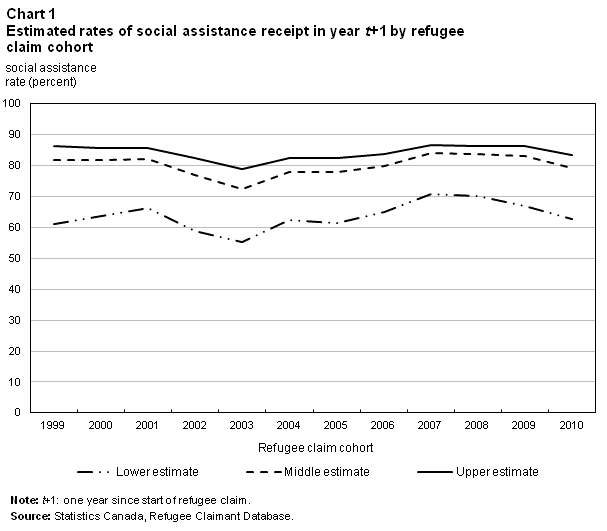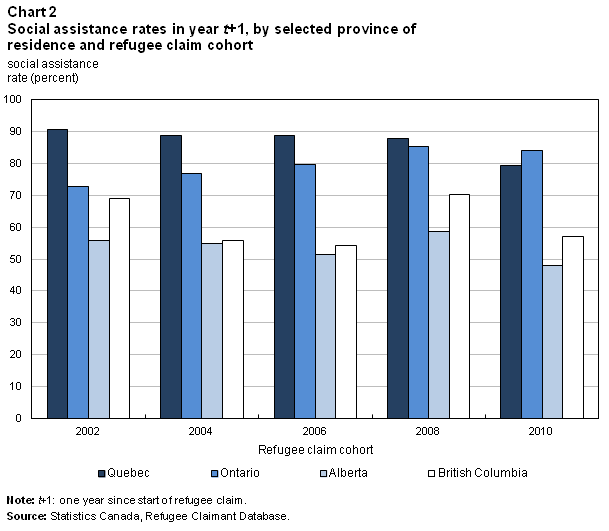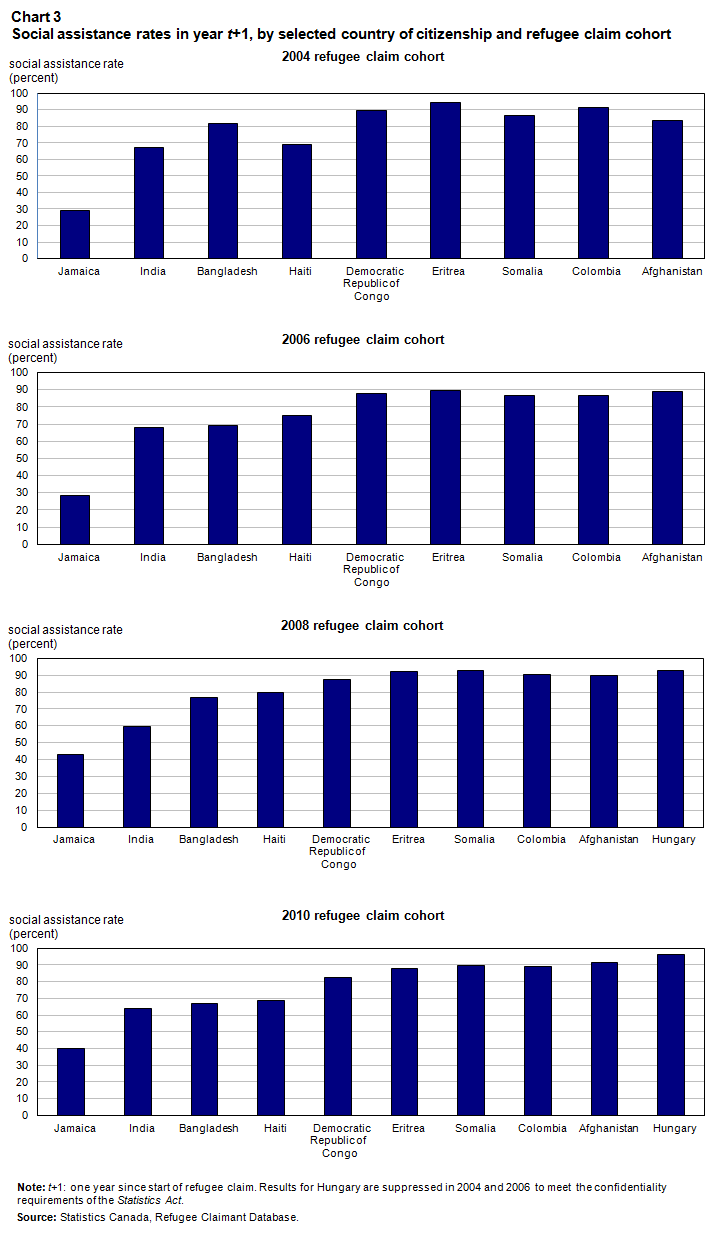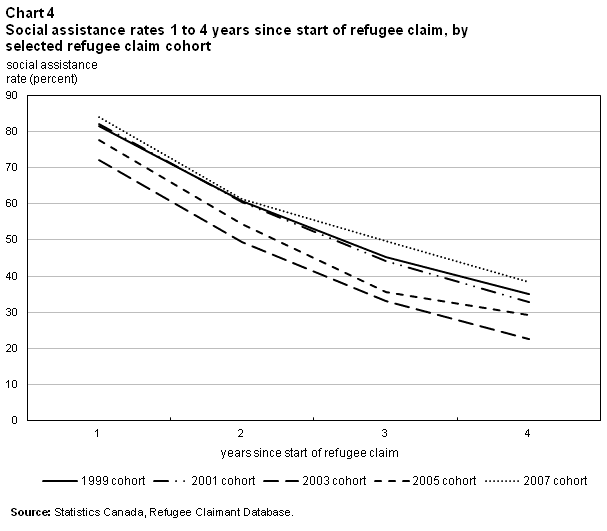by Yuqian Lu, Marc Frenette and Grant Schellenberg
Social Analysis and Modelling Division

Introduction
Refugee claimants are people who request refugee protection upon or after arriving in Canada. They receive Canada’s protection if they are found to be Convention refugees as defined by the United Nations 1951 Geneva Convention Relating to the Status of Refugees, or when they are found to need protection based on risk to life, risk of cruel and unusual treatment or punishment, or danger of torture. During the latter part of the 2000s, the number of refugee claimants in Canada ranged from 115,000 to 130,000.
This article presents information about the receipt of social assistance by refugee claimants who initiated their claim for protection during the 1999-to-2010 period. Until now, no data source has been able to supply information on social assistance receipt among the refugee claimant population.
Most refugee claimants could be linked to tax data and social assistance records and then grouped into families (social assistance eligibility is determined at the family level). The study examines: (1) the percentage of refugee claimants who received social assistance; (2) the incidence of social assistance receipt, by province of residence, country of citizenship, and family characteristics; (3) the evolution of social assistance receipt with time spent in Canada; and (4) expenditures on social assistance paid to refugee claimants.
Majority receive social assistance shortly after arrival
For approximately three-quarters of refugee claimants who arrived in Canada from 1999 to 2010, information about social assistance was available—that is, they could be linked to tax data and social assistance records, and families could be identified. The remaining one-quarter could not be linked, so no data on social assistance were available for these refugee claimants.
If it is assumed that none of the unlinked individuals received social assistance, the overall rate of social assistance receipt was about 65%, depending on the arrival cohort (the lower-bound estimate in Chart 1). Conversely, if it is assumed that all the unlinked individuals received social assistance, the rate of receipt was generally about 85% (the upper-bound estimate in Chart 1). The middle estimate in Chart 1—generally about 80%—is the social assistance rate estimated for refugee claimants for whom data were available.
Unless otherwise stated, the middle estimate is used in the remainder of this analysis.

Rates highest in Quebec and Ontario, lowest in Alberta
In the year after they arrived in Canada, the vast majority of refugee claimants lived in one of four provinces: Ontario (53% to 70% depending on the year), Quebec (20% to 35%), British Columbia (3% to 8%), and Alberta (2% to 6%).
Rates of social assistance receipt were generally highest among refugee claimants in Ontario and Quebec (Chart 2). For example, among those who arrived in 2010, rates of social assistance receipt were 84% in Ontario and 79% in Quebec. In British Columbia and Alberta, the rates were 57% and 48%, respectively.
Social assistance receipt varied across the other provinces and the territories, but few refugee claimants settled in those areas.

Social assistance receipt also varied according to the country of citizenship of the refugee claimants (Chart 3). The country of citizenship of refugee claimants is also strongly associated with social assistance receipt. While there are variations over time, some trends hold throughout most of the study period. For example, at least 90% of those from Afghanistan, Colombia, the Democratic Republic of Congo, Eritrea, and Somalia collected social assistance income shortly after arrival. In the latter part of the 2000s, this list also included claimants from Hungary.
Rates of social assistance receipt were lower among refugee claimants from Bangladesh, Haiti, India, and Jamaica. The rates were particularly low among Jamaican claimants who arrived before 2007 (less than 30%). Since then, slightly more than 40% of Jamaican claimants have collected social assistance income shortly after arrival, but this was still well below the rates for any other group.

Rates of social assistance receipt varied by family composition, age of the oldest family member, and whether someone in the family held a work permit, but the associations were weaker. For example, among refugee claimants who arrived between 2005 and 2010, the rate was about the same, regardless of whether or not a family held a work permit: 82% and 84%, respectively.
Rates decline with time in Canada
Among refugee claimants whose claim remained open, the rate of social assistance receipt declined considerably over time (Chart 4). For example, among those who arrived in the early 2000s and whose claim was still active four years later, the rate ranged from 25% to 40%—about half what it had been the year after arrival. During the same period, about 8% of the Canadian population received social assistance income.

Less than 5% of total social assistance expenditures paid to refugee claimants
Although refugee claimant families are far more likely than the broader Canadian population to receive social assistance income, it is important to keep in mind that refugee claimants only represent about one-third of 1% of the total Canadian population. Overall, refugee claimant families receive less than 5% of total social assistance payments made in Canada (Table 1).
From 1999 through 2011, $10 billion to $13 billion were disbursed annually in social assistance payments in Canada. Of these totals, a minimum of $202 million to $338 million (1.9% to 3.2%) was paid to refugee claimants, depending on the year.
These estimates are likely conservative, since social assistance information was not available for about one-quarter of all refugee claimants.
Assuming that social assistance receipt patterns were similar for linked and unlinked refugee claimants, the annual amounts paid to refugee claimants would have ranged from $284 million and $462 million, or 2.7% to 4.4% of total social assistance expenditures
Table 1
Social assistance benefits paid to refugee claimants by year, 1999 to 2011
| Year | Total SA benefits (T5007 file) | Total SA benefits paid to RCs (T5007 file and T1FF) | Percentage of SA benefits paid to RCs (T5007 file and T1FF) | Predicted total SA benefits paid to RCs (T5007 file and T1FF, unlinked included) | Predicted percentage of SA paid to RCs (T5007 file and T1FF) |
|---|---|---|---|---|---|
| 2011 constant dollars | 2011 constant dollars | percent | 2011 constant dollars | percent | |
| 1999 | 12,720,599,370 | 236,875,624 | 1.9 | 355,145,983 | 2.8 |
| 2000 | 11,717,799,462 | 257,300,460 | 2.2 | 381,388,639 | 3.3 |
| 2001 | 11,111,833,301 | 302,774,927 | 2.7 | 432,057,737 | 3.9 |
| 2002 | 10,604,219,149 | 337,936,280 | 3.2 | 461,719,590 | 4.4 |
| 2003 | 10,251,014,042 | 323,237,824 | 3.2 | 442,453,451 | 4.3 |
| 2004 | 10,255,760,310 | 284,246,731 | 2.8 | 392,020,556 | 3.8 |
| 2005 | 10,268,147,571 | 240,181,185 | 2.3 | 331,527,714 | 3.2 |
| 2006 | 10,274,813,861 | 205,056,435 | 2.0 | 287,171,965 | 2.8 |
| 2007 | 10,422,332,544 | 201,605,857 | 1.9 | 283,756,988 | 2.7 |
| 2008 | 10,553,340,967 | 242,407,509 | 2.3 | 344,977,223 | 3.3 |
| 2009 | 11,624,450,454 | 324,633,550 | 2.8 | 443,310,191 | 3.8 |
| 2010 | 12,066,912,323 | 319,008,634 | 2.6 | 429,676,580 | 3.6 |
| 2011 | 12,192,859,489 | 290,680,087 | 2.4 | 397,842,359 | 3.3 |
| Note: SA: social assistance; RCs: refugee claimants; T1FF: T1 Family File. Source: Statistics Canada, Refugee Claimant Database. |
|||||
Conclusion
Four major findings emerge from this study.
First, 65% to 85% of refugee claimants received social assistance shortly after arriving in Canada.
Second, rates of social assistance receipt among refugee claimants varied more by province of residence and country of citizenship than by family characteristics.
Third, the percentage of refugee claimants receiving social assistance declined considerably with time in Canada. However, four years after arrival, the rate was still three to five times higher than the rate for Canada overall.
Finally, estimates of the percentage of total social assistance expenditures received by refugee claimants ranged from 1.9% to 4.4%.




